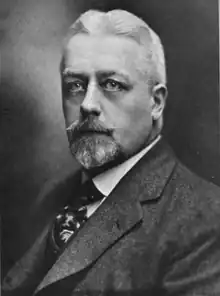Arvid Reuterdahl | |
|---|---|
 | |
| Born | February 15, 1876 |
| Died | January 13, 1933 |
| Occupation(s) | Engineer, writer |
Arvid Reuterdahl (February 15, 1876 – January 13, 1933) was a Swedish-American engineer, scientist and educator.
Biography
Reuterdahl was born at Karlstad on February 15, 1876.[1] He moved to the United States as a child in 1882. He graduated Sc.B. from Brown University in 1897 and was a mathematics and physics instructor at the Technical High School in Providence.[1] Reuterdahl worked as an engineer in Spokane, Washington for five years and as an assistant city engineer, water commissioner and President of the board of public works.[1] He designed bridges for the city. He was an consulting engineer of Boise, Idaho (1910–1913) and Kansas City, Missouri (1913–1918).[1]
He was professor of theoretical and applied mechanics at Kansas City Polytechnic Institute (1915–1918) and was the first Dean of the Department of Engineering and Architecture at the College of St. Thomas (1918–1922).[1][2] He was President of the Ramsey Institute of Technology, Saint Paul, Minnesota (1922-1926).[1]
He was a Fellow of the American Association for the Advancement of Science. He married Elinor Morrison on June 16, 1902. They had one son, Norman Morrison Reuterdahl.[1]
Opposition to the theory of relativity
Reuterdahl was a noted opponent of Albert Einstein's theory of relativity.[3][4][5] He considered Einstein's theory to be largely "bunk" and accused him of plagiarism.[6][7] Reuterdahl argued that Einstein's theory of relativity was plagiarized from a mechanical gravitation theory of Scottish engineer Robert Stevenson (pseudonym Kinertia). He argued that Stevenson's papers were sent to the Prussian Academy of Sciences in 1903 and that Einstein, a member of the Academy secretly made use of the papers.[5]
Reuterdahl communicated with other anti-relativists such as Ernst Gehrcke.[8] He was science editor for Henry Ford's journal the Dearborn Independent.[4]
Selected publications
- Scientific Theism Versus Materialism: The Space-time Potential (1920)
- Einstein and the New Science (1921)
- "Kinertia" Versus Einstein (1921)
- A Synthesis of Number, Space-Time and Energy (1923)
- The God of Science (1928)
- Einsteinism: Its Fallacies and Frauds (1931)
References
- 1 2 3 4 5 6 7 The National Cyclopædia of American Biography. New York: James T. White & Company, 1927. pp. 468-469
- ↑ "Arvid Reuterdahl Papers". University of St. Thomas. Retrieved 25 January 2021.
- ↑ Heidenreich, E. L (2004). "Reuterdahl vs. Einstein: Nailing a Fallacy". The Mathematical Intelligencer. 26 (2): 63–66. doi:10.1007/BF02985657. S2CID 119664363.
- 1 2 Wazeck, Milena (2013). "Marginalization Processes in Science: The Controversy about the Theory of Relativity in the 1920s". Social Studies of Science. 43 (2): 163–190. doi:10.1177/0306312712469855. S2CID 145087411.
- 1 2 Wazeck, Milena. (2014). Einstein's Opponents: The Public Controversy about the Theory of Relativity in the 1920s. Cambridge University Press. pp. 171-173. ISBN 978-1-107-01744-3
- ↑ "April 10, 1921: St. Thomas prof calls Einstein's theory 'bunk'". Star Tribune. Retrieved 25 January 2021.
- ↑ "The Origin of Einsteinism; Prof. Reuterdahl, Replying to Mr. Bond, Says That, in the Absence of Proofs of Innocence, Ein-stein Stands Convicted of Plagiarism". The New York Times. Retrieved 25 January 2021.
- ↑ Rowe, David E. (2018). A Richer Picture of Mathematics: The Göttingen Tradition and Beyond. Springer. p. 260. ISBN 978-3-319-67818-4